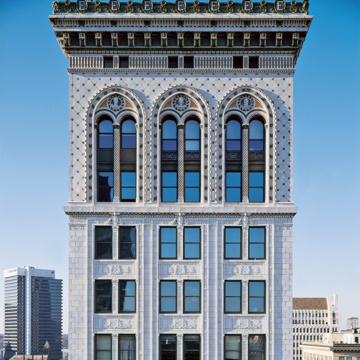You are here
Elyton Hotel
The Empire Building is one of nine steel-frame skyscrapers that rose in downtown Birmingham between 1902 and 1913, announcing that the post–Civil War city (founded in 1871) had “arrived” as an urban center. The proliferating skyscrapers tell of rapid growth fed by nearby deposits of coal, iron, and limestone, and by the foundries and mills that turned the raw materials into a new economic base for the region. At the time it was built, the sixteen-story Empire Building—gleaming white with classical details and eye-catching color accents—stood out vividly against the industrial soot and red brick, two- and three-story Victorian buildings that characterized the city.
The Empire is the third of the four skyscrapers, all extant, that make up the intersection of First Avenue and Twentieth Street, nicknamed by local boosters the “Heaviest Corner on Earth.” The first two skyscrapers (the Woodward and Brown-Marx buildings) are designed in the tradition of the Chicago School and are sheathed in brick, while the latter two (the Empire and American Trust and Savings Bank buildings), feature glazed, white terra-cotta in the Classical Revival style associated with New York City skyscrapers.
The Empire Building’s elegant proportions are anchored at the base by two monumental Doric columns in subdued pinkish granite, marking the entrance, and crowned at the top by paired two-story, round-headed arched windows within a Gothic arch, with a handsome cornice projecting above. The large “E” set in shields along the edge of the cornice stands for the Empire Improvement Company , the development entity from which the building took its name. The building showcases the decorative versatility of molded terra-cotta, expressed in twisted columns, busts, and an array of classical embellishment, including arabesques, cartouches, acanthus leaves, and more.
Architects J.E.R. Carpenter and Walter D. Blair of New York City worked with younger architects William T. Warren and William Leslie Welton, who had recently (1907) relocated to Birmingham from New York, where they practiced in the office of McKim, Mead and White. After the Empire Building’s completion, Warren and Welton briefly had their offices there until the partnership dissolved in 1910.
In addition to its architectural significance, the Empire Building is important for its early association with Birmingham’s preeminent local real estate developer, Robert Jemison Jr., who had tremendous influence shaping the quality of the city’s built environment—both urban and suburban—over many decades of the twentieth century.
In 1964, Empire Building was purchased and renovated by City National Bank, which merged into Colonial Bank in 1982. Renovated the following year by Renneker, Tichansky and Associates, the building housed the bank on its ground level until the financial institution failed in 2009. Vacant since that time, the building has since undergone a $45 million renovation and opened in July 2017 as the Elyton Hotel, a 111-room luxury hotel that features a restaurant, rooftop bar, and event space.
References
Fazio, Michael W. Landscape of Transformations: Architecture and Birmingham, Alabama .Knoxville: University of Tennessee Press, 2010.
Schnorrenberg, John M. Remembered Past Discovered Future: The Alabama Architecture of Warren Knight & Davis, 1906-1961.Birmingham, AL: Birmingham Museum of Art, 1999.
Writing Credits
If SAH Archipedia has been useful to you, please consider supporting it.
SAH Archipedia tells the story of the United States through its buildings, landscapes, and cities. This freely available resource empowers the public with authoritative knowledge that deepens their understanding and appreciation of the built environment. But the Society of Architectural Historians, which created SAH Archipedia with University of Virginia Press, needs your support to maintain the high-caliber research, writing, photography, cartography, editing, design, and programming that make SAH Archipedia a trusted online resource available to all who value the history of place, heritage tourism, and learning.






